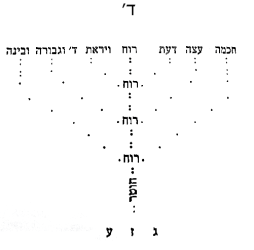John D. Brey
Well-Known Member
Another recent thread here mentioned Revelation 22:4 in the context of the "knowers and the chosen" who've seen God's face. Since I don't know the context for "knowers and chosen," and since I don't want to weigh down that thread with too much jargon, I'm starting this thread on the primary topic of Revelation 22:4:
Revelation 22:4 juxtaposes the engraving or sign (χαραγμα) in the forehead (and hand) of the worshipers of the Beast, with this name found in, or on, the forehead of the servants of the Lamb of God. On the former χαραγμα (sign or engraving) in the hand and head of the worshipers of the Beast, Kittel's, The Theological Dictionary of the New Testament, says:
Kittel goes on to point out that this kind of stigmatization was common in antiquity (and gives ample examples). Furthermore:
The preterist idea that Nero is in view is invalid outside the thinking of theological invalids. Nevertheless, Kittel does point out that the marking in worship of the Beast is said, mirroring Revelation 22:4, to be the "name" of the Beast etched or written on the foreheads (μέτωπον) of his worshipers.
John
And they shall see his face; and his name shall be in their foreheads.
και οψονται αυτον το προσωπον και αυτον το ονομα επι αυτον των μετωπον.
Revelation 22:4 juxtaposes the engraving or sign (χαραγμα) in the forehead (and hand) of the worshipers of the Beast, with this name found in, or on, the forehead of the servants of the Lamb of God. On the former χαραγμα (sign or engraving) in the hand and head of the worshipers of the Beast, Kittel's, The Theological Dictionary of the New Testament, says:
3. Rev. 13:11–18 describes the appearance of the second beast, which comes as the pseudo-prophet of the first beast (→ III, 135, 18 ff.), demanding religious recognition of its cultic image. The incident gains in dramatic force as this image itself comes to life and begins to speak (v. 15). It demands of all men without exception ἵνα δῶσιν αὐτοῖς χάραγμα ἐπὶ τῆς χειρὸς αὐτῶν τῆς δεξιᾶς ἢ ἐπὶ τὸ μέτωπον αὐτῶν, καὶ ἵνα μή τις δύνηται ἀγοράσαι ἢ πωλῆσαι εἰ μὴ ὁ ἔχων τὸ χάραγμα τὸ ὄνομα τοῦ θηρίου ἢ τὸν ἀριθμὸν τοῦ ἀνόματος αὐτοῦ, v. 16f. That the religious totalitarianism of emperor worship is indicated here is evident. Probably the choice of the word χάραγμα points to this if the reference is to the imperial stamp → line 11 f. Materially, however, the required acceptance of the χάραγμα means religious signing with the mark of the beast, which is branded on the right hand or the forehead
Kittel goes on to point out that this kind of stigmatization was common in antiquity (and gives ample examples). Furthermore:
In Rev. 13:18 the mark of the beast is described as the name of the beast (→ V, 280, 9 ff.) concealed in the number 666 (→ I, 462, 16 ff.). If Nero is in view, the meaning of the number fits the context best, for in this case there is confrontation between the claim of the emperor and that of the Christ, whose seal (→ VII, 951, 1 ff.) is borne by the 144,000 servants of God who belong to Him, Rev. 7:1–8.
The preterist idea that Nero is in view is invalid outside the thinking of theological invalids. Nevertheless, Kittel does point out that the marking in worship of the Beast is said, mirroring Revelation 22:4, to be the "name" of the Beast etched or written on the foreheads (μέτωπον) of his worshipers.
The fact that this politico-religious clash [the Beast and his worshipers vs. the worshipers of the Lamb of God] is meant may be seen from other passages in Rev. which refer back to 13:16f. The angel in 14:9, 11 threatens with eschatological wrath all those who have accepted the χάραγμα of the beast. The execution of this threat is described in 16:2 and judgment on the beast and his false prophet in 19:20, while in 20:4 all those who have not worshiped the beast or his image, nor accepted his marks on the hand or forehead, are exalted as eschatological judges.
John
Last edited:

